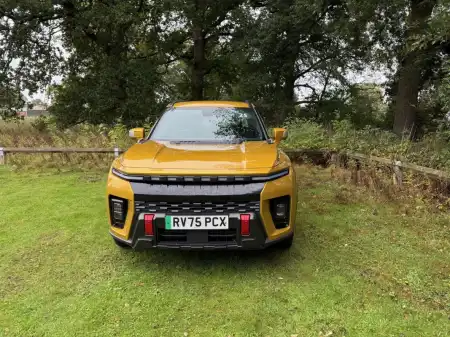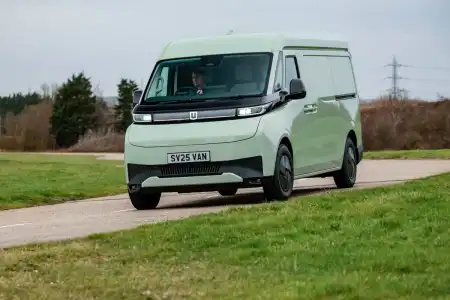- Large payload limit
- Well-equipped throughout the range
- Great value
- Smaller than some rivals
- Basic cabin design
- Awkward seating position
Introduction
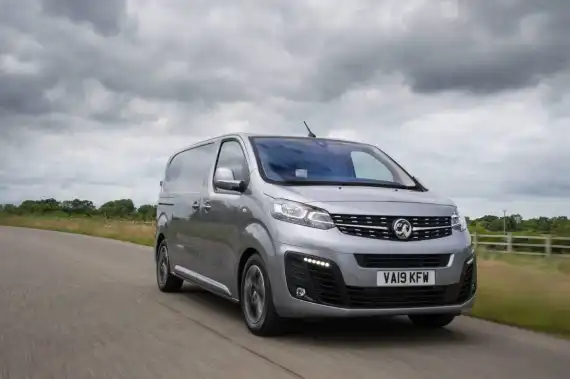
Ford might dominate the sales charts, but Vauxhall is right up there with its Vivaro, the second-best-selling medium van in the UK. It’s part of the Stennaltis quintet that includes the Citroen Dispatch, Fiat Scudo, Peugeot Expert and Toyota Proace, but last year managed to outsell all of those combined. Twice over.
Vauxhall is clearly doing something right. Its extensive dealer network ensures servicing is easy, the van is competitively priced both in cash and leasing terms, and there’s no doubt about its versatility and capability. An ell-electric model joined the range in 2020, providing owner-operators and fleets with a range of vehicles to cover almost any circumstance, with the backup you need when your livelihood relies on your wheels. Looking beyond total cost of ownership concerns, the array of Vivaros includes two body lengths (although there’s just one roof height option) and two cab choices (the regular three-seater cab or the six-seater DoubleCab). There’s also a platform cab, ready for conversions such as beaver tails or hydraulic lifts. Three trim levels, three engine choices, three weight classifications and a pair of gearbox options create a baffling array of possible combinations. And if you do get your head around it, Vauxhall is mixing things up again by introducing the 180hp Vivaro GS sports van early next year. Cosmetically, there’s not much to choose between them. Entry-level models get grey plastic bumpers and steel wheels, while higher models receive body-coloured trim, splashes of chrome, and smart alloy wheels. The GS will also introduce a roof spoiler and some flashier bits of trim.
On The Road
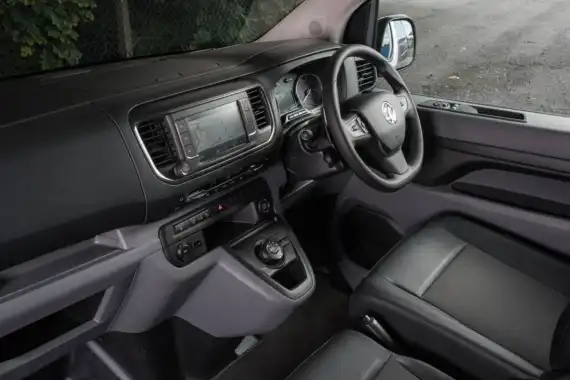
Handling & Performance
Even the base-level Vivaro comes reasonably well equipped, with a 7.0-inch infotainment screen, providing access to Apple CarPlay and Android Auto integration, DAB radio, and Bluetooth connectivity. Drivers will be pleased to find air conditioning, while rear parking sensors should help manoeuvring in tight spaces. Higher specification models receive a handy reversing camera, satellite navigation, cruise control, and improved safety features. No driver will feel hard done by, especially when you compare the Vivaro to lesser-equipped rivals. Car-like equipment it may have, but the cabin falls a bit short of offering car-like design and comfort. Simple but functional is a polite way of describing it, but it’s ergonomically sound. Well, almost. All of the controls are where you’d like them to be, and the infotainment centre is clear and easy enough to use, but the driver’s seating position is awkward; the steering wheel and pedals are offset, in different directions, leading to a permanent twist in the body as you drive. Storage for all of your oddments is superb, though, with substantial door bins that will swallow countless bottles, newspapers and clipboards. There’s a handy cubby hole on top of the dashboard, a decent glovebox and, critically, plenty of cupholders on both sides of the van. A small shelf sits under the infotainment screen, next to the USB socket, asking to be used to store your smartphone, but resist; not only is it not quite big enough for a modern phone, but it’s also hard and shiny. The lack of a rubber pad means your phone will shoot off onto the cabin floor at the first corner. On the road, it’s a fine van. The 100hp model we had to try is the lowest-powered van in the Vivaro range, but it coped admirably with the demands placed on it. Sadly, we didn’t get to try it with anything approaching a full load in the back, but our experience with the same engine in other Stellantis models suggests it’ll be fine for the job at hand. Engine choices with 120hp and 145hp are available, with a 180hp model joining the range next year. Handling is, in the most positive way, entirely unremarkable. The front feels very light, with little feedback through the wheel, which saps a little confidence when travelling across country, but makes urban driving a cinch. Hit the motorway, and you will find the Vivaro’s natural habitat, where it feels solid, stable, and planted, with impressive ride quality. Noise is even kept well in check, too.
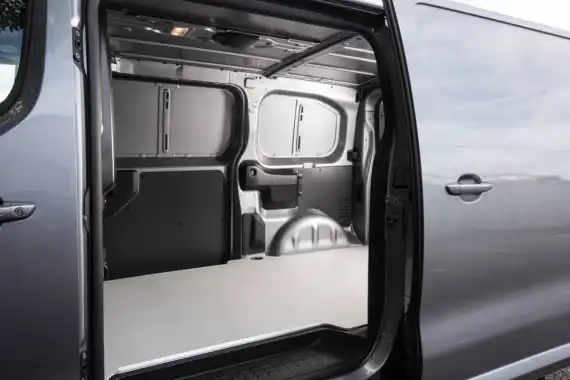
Space & Practicality
Unlike some rivals, the Vivaro benefits from a sliding door on each side of the van, making access to the load box convenient whichever way around you’ve parked. Double rear doors are standard, too, although you can specify a lifting tailgate.
The cargo bay is functional, with near upright sides and good straight lines throughout. Wheel arch intrusion is minimal, too, although you’ll never get rid of it entirely. Vauxhall has included lashing points around the van, which is a nice touch, but you might struggle to see them at dusk and beyond - the lighting is awful, with a couple of old-fashioned bulbs rather than some bright LED panels.
Our Vivaro was an L2 model, so the longer version of the van, which gave a cargo volume of 6.1m3. That’s competitive but not class-leading. At its longest point, you can squeeze a load length of up to 2,82mm in there, but the Vivaro has an extra trick up its sleeve. A load-through panel in the solid bulkhead allows you to securely pop long, thin loads through to the cabin, expanding the maximum length to 4,024mm. While the Ford Transit Custom has a longer cargo bay and greater volume, it can’t compete with that extended capability. Both will squeeze three Euro pallets on board, so the real-world difference is minimal.
Payload limits for our van were set at 1,060kg -already impressive compared to the Ford - with the rest of the range rising from there, reaching as far as 1,458kg. Gross vehicle weights are set at 2.7, 2.9 or 3.1 tonnes, depending on the specification you order, with gross combination weights reaching 5.6 tonnes.
Towing limits are set at 2.5-tonnes for models with the higher-power 145hp engine, but those, like us, with the lower 100hp or 120hp units, will have to make do with between 1,800 and 2,000kg.
Ownership
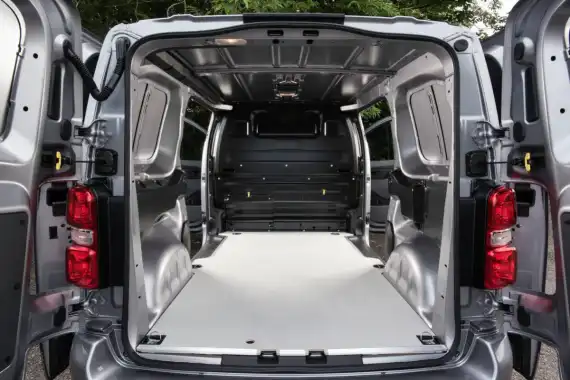
Running Costs
List prices for the Vivaro are competitive, but things get confusing regarding leasing or PCP costs. At the time of writing, rates for our mid-range test van hover around £350 a month, which is a little steep compared to some rivals. However, the still well-specified entry-level models are £100 cheaper, representing excellent value.
Economy from the 100hp engine is impressive, with WLTP testing promising 41.5mpg. Our onboard computer showed 36mpg, which is reasonably close and comes with caveats; a heavy right foot will have adversely affected it, but the light loads we carried would have benefited the economy figures.
Drivers will rarely have to see a Vauxhall dealer for servicing, as it’s required just once every 25,000 miles or every two years, at least for the 100hp and 120hp models. The 145hp unit does even better, extending the intervals to 30,000 miles, although the same two-year limit still applies.
Should there be a problem, a 100,000-mile warranty that lasts for three years will see most through a regular lease deal. It’s worth noting for owner-operators and smaller fleets that don’t change vans quite so frequently that the all-but identical Toyota Proace van has a warranty that can run for as long as 10 years, albeit with a couple of catches.
Verdict

The Vivaro has just two significant rivals; the Ford Transit Custom and itself, albeit wearing a Citroen, Fiat, Peugeot or Toyota badge. The Vauxhall feels a step behind the Ford, with a tighter cabin and more compact load area, but the Vivaro’s higher maximum payload might be just what you need.
You can’t ignore the impressively good value finance options available for the Vivaro, either, which will work to keep monthly costs down and lower your total cost of ownership. Overall though, there’s little to split the Vauxhall from its rival from Ford. The Vauxhall takes a win if you need maximum payload in a medium size van, but the Ford is more cavernous and nicer to live with.
If the Vauxhall is the right van for you, it’s also worth looking at the Citroen Dispatch, Fiat Scudo, Peugeot Expert or Toyota Proace. All have pros and cons, mainly in terms of costs rather than cargo carrying, but the physical differences are only skin deep, so choose with your head.

